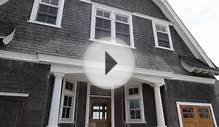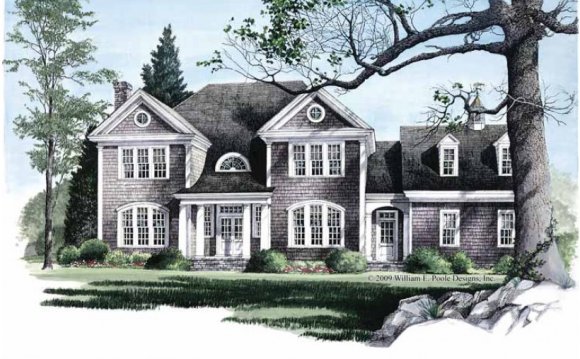
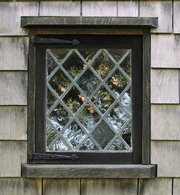 Medieval-style window
Medieval-style window
Sunset Hill c. 1686
Built by Jethro Coffin, grandson of one of the
first settlers, Tristram Coffin.
Sometime about 1715 Capaum Harbor was closed due to repeated storms that silted in the entrance, creating Capaum Pond. The settlers were forced to relocate to the harbor on the south side of the island, the area now known as Nantucket Town. Because timber had to be brought from the mainland, their homes were too valuable to leave behind, so they were moved, or taken apart and rebuilt at the new site.
Although the lean-to style lasted until the end of the 18th century, there was a gradual transition from the early colonial architecture to a style that would be unique to Nantucket and often referred as the "Typical Nantucket House."
Examples of early lean-tos:
Jethro Coffin House c. 1686
Sunset Hill
Joseph Gardner House c. 1688-1690
139 Main Street
Christopher Starbuck House c. 1690
105 Main Street (Monument Square)
Richard Gardner House c. 1722-1724
32 West Chester Street
Barnabas Gardner c. 1739
153 Main Street
Christopher Folger/Sara Turner House c. 1753
86 Centre Street
Typical Nantucket House 1770-1830
By the end of the 18th century, Quaker influence, which had been growing since the early 1700s, reached its height and over half the town’s population were members of the “Friends” when most of these houses were built. While the Quakers enjoyed fine homes, they eschewed ostentation in any form and most of the interiors and exteriors of houses built during this time feature very little decoration or ornamentation.
The typical Nantucket house is a two-story structure capped with a pitched roof. Lacking the symmetry of the primitive colonial style, these homes featured off-center windows, doorways and chimneys. While fireplace openings were smaller, windows grew larger and were set in plank frames that extended beyond the exterior walls. The entrance, as originally built, was merely a projected plank frame similar to that of the windows with a raised panel door and “lights” or a transom above it. You will find houses of this style with more elaborate front door frames, columns and decorative molding, but these were usually added later after the Quakers lost their stronghold on the island.
Joseph Swain House c. 178284 Main Street
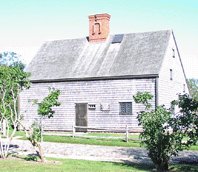 Many of these typical Nantucket houses, particularly those owned by successful sea captains and ship owners, have widows walks, sometimes known as roof walks or Captain’s Walks. These viewing platforms, built on top of the roofs, provided panoramic views of the horizon.
Many of these typical Nantucket houses, particularly those owned by successful sea captains and ship owners, have widows walks, sometimes known as roof walks or Captain’s Walks. These viewing platforms, built on top of the roofs, provided panoramic views of the horizon.
Examples of the Typical Nantucket House:
Joseph Swain c. 1762
84 Main Street
Job Macy c. 1790
11 Mill Street
Thomas Starbuck c. 1761
11 Milk Street
Richard Macy/Daniel Worth c. 1768
10 Gardner Street
Swain-Mitchell House c. 1790
1 Vestal Street
Siasconset Cottages
For a many years after the settlement of the island, a number of Nantucket fisherman earned their livelihood fishing the shores. Cod was plentiful and early settlers traveled from town to the remote eastern end within a few years of their arrival. By the 1670’s, Siasconset, or ‘Sconset as it is better known, was one of four fishing “stands, ” or stations, where fisherman lived during the spring and fall cod-fishing seasons. The fishermen built small cottages to accommodate the five men fishing crews. But these were not the charming cottages you see today. Rather, these were little more than one room wooden shacks with shingled roofs and dirt floors. Cooking was done in the open air or on open porches.
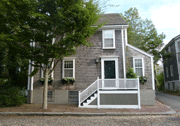 Fisherman brought their families out during the summer months, and eventually many of them decided to make ‘Sconset their permanent home. They began making improvements on their tiny dwellings to provide year-round shelter. But instead of tearing them down, additions were made using odds and ends including old doors and windows, and occasionally parts of wrecked ships. Many of the fishing shanties turned cozy cottages still stand today. Most visitors would never guess that these charming rose-covered cottages, architectural treasures in their own right, started off as fishing shacks.
Fisherman brought their families out during the summer months, and eventually many of them decided to make ‘Sconset their permanent home. They began making improvements on their tiny dwellings to provide year-round shelter. But instead of tearing them down, additions were made using odds and ends including old doors and windows, and occasionally parts of wrecked ships. Many of the fishing shanties turned cozy cottages still stand today. Most visitors would never guess that these charming rose-covered cottages, architectural treasures in their own right, started off as fishing shacks.
Examples of historic Siasconset cottages:
“Auld Lang Syne” (Micah Coffin House) c. 1675
6 Broadway (possibly the oldest structure on the island)
“Shanunga” (Betsey Cary Cottage) c. 1682
10 Broadway
William Brown c. 1814
26 Broadway Street
“Nauma” (Rachel Paddock House) c. 1750
27 Broadway Street
“Whalespray” c. 1796
29 Broadway Street
Silas Parker c. 1794
7 School Street
Federal Period
The Nantucket whaling industry reached new heights following the turbulent years of the American Revolution, and the inhabitants welcomed a period of great success and prosperity. Increasing profits enabled the islanders to build larger and more elaborate houses and the desire to keep up with changing times resulted in many homeowners turning away from the more conservative styles favored by the Quakers.
The Federal style of architecture, already popular on the mainland, began to take root on Nantucket. Balance and symmetry replaced the off-centered styles of the typical Nantucket house. Entrances were once again placed in the center of the house with side lights and two windows on either side. Projected plank frames continued to be used but the panes of glass became larger in size and fewer in number. Fireplace openings were smaller and framed by mantels with shelves and featured two or four chimneys instead of one central chimney.
Swain-Macy House c. 177099 Main Street
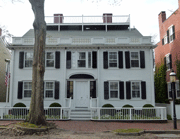 Although the Federal style was widely adopted by the islanders, the popular motifs such as eagles and stars were absent from island architecture, due in part to the lingering, but waning, Quaker influence.
Although the Federal style was widely adopted by the islanders, the popular motifs such as eagles and stars were absent from island architecture, due in part to the lingering, but waning, Quaker influence.
Examples of Federal style:
Perez Jenkins c. 1808
82 Main Street
Swain-Macy House c. 1770
99 Main Street
Worth-Gardner House c. 1780
3 Academy Lane
1800 House (Richard Coleman) c. 1801
4 Mill Street
Captain Silas Jones House c. 1774
5 Orange Street
Hinchman House c. 1800-1810
7 Milk Street
Greek Revival Period
The War of 1812 would prove to be another turning point in the island's history. By this time, the island’s entire economy was tied to the whaling industry and that came to an abrupt halt with the outbreak of the war. Nantucketers suffered and struggled through the next three years, but by 1815, whaling vessels were once again heading out for the open sea.
Between 1820 and 1850, the decorative Greek-Revival style of architecture swept the mainland. The wealthy islanders were not far behind. By the mid 1830s, Nantucket ship owners and sea captains were wealthy, well-traveled men. Although many still belonged to the Quaker sect, escalating division and bitter infighting had weakened the Quaker domination on the island.
It was during this time that Nantucket’s first “mansions” were built. Brick was used as well as wood, and about a dozen large brick mansions were constructed at the height if the island's prosperity. Perhaps best known are “The Three Bricks”, the three brick mansions at 93, 95, and 97 Main Street, built by wealthy Joseph Starbuck for his three sons between 1837 and 1840.
In 1846 a devastating fire broke out on Main Street. Fed by casks of whale oil in its path, the fire raged towards the harbor, destroying stores, factories and warehouses along with some 300 houses, leaving hundreds homeless and improverished. The loss was estimated at nearly one million dollars. Nantucketers were quick to rebuild, and the new Greek Revival style was used extensively in residential as well as public buildings.
Examples of Greek-Revival architecture can be found in some form on every street in Nantucket town, although the largest concentration is on Main Street, where the prosperous whaling merchants and sea captains made their home.
The Three Bricks93, 95, 97 Main Street
c. 1837-1840
Examples of Greek Revival style:
The Three Bricks (Joseph Starbuck) c. 1837-1840
93, 95, and 97 Main Street
Hadwen-Wright House c. 1845
RELATED VIDEO
